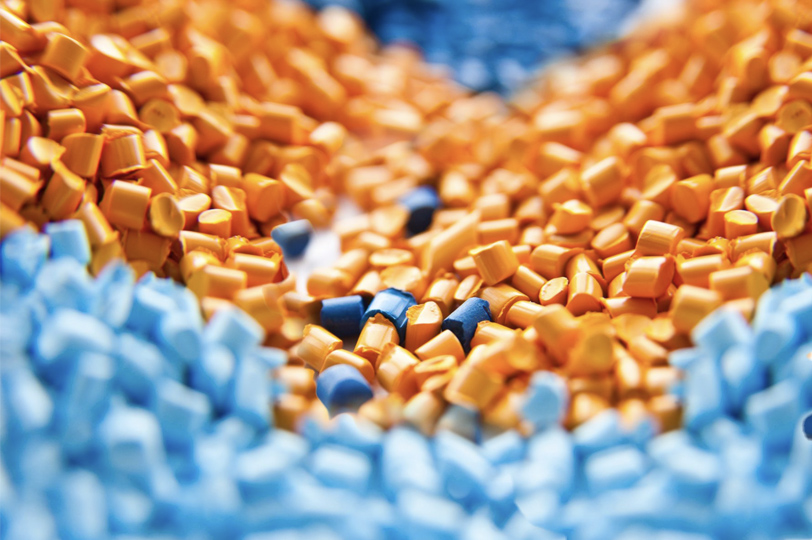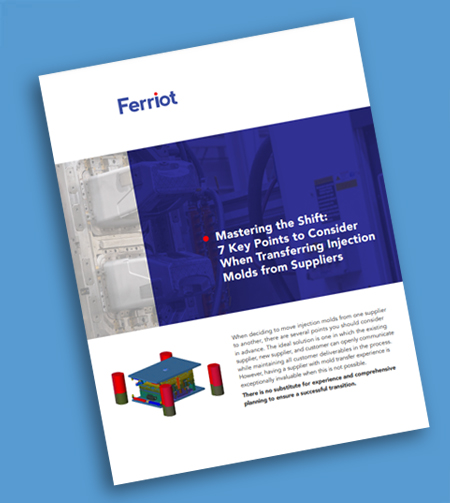Creating a successful injection molded component requires collaboration and the expertise of a skilled team. One of the most critical aspects of the design for manufacturing (DFM) process is selecting the appropriate resin. Choosing the right injection molding resin not only meets design goals and performance specifications but also aligns with budget constraints. By working closely with injection molding experts, you can engineer a solution that fits your needs perfectly.
Before diving into resin options, it’s essential to clearly define the end goals for your product. Once these are set, you can narrow down the best resin choices. Here is an in-depth overview of the 12 steps to help you select the right plastic for your injection molding project:
 Analyze Part Geometry The size, shape, and wall thickness of the part can significantly impact its moldability. Parts with complex geometries or uneven wall thicknesses might be prone to warping, bowing, or other design issues. Early analysis using tools like Moldflow® software can identify these potential problems and suggest design modifications. For instance, resins like polypropylene (PP) are often used for parts with complex geometries due to their excellent flow properties and low shrinkage.
Analyze Part Geometry The size, shape, and wall thickness of the part can significantly impact its moldability. Parts with complex geometries or uneven wall thicknesses might be prone to warping, bowing, or other design issues. Early analysis using tools like Moldflow® software can identify these potential problems and suggest design modifications. For instance, resins like polypropylene (PP) are often used for parts with complex geometries due to their excellent flow properties and low shrinkage. Define the Design Goals for the Part Clarifying the main objectives of injection molding the part is crucial. Are you looking to reduce weight? For example, using lightweight resins like polycarbonate (PC) might be ideal. Are you trying to consolidate an assembly into fewer components or cut costs? High-performance engineering resins like polyamide (nylon) could provide the necessary strength and durability.
Define the Design Goals for the Part Clarifying the main objectives of injection molding the part is crucial. Are you looking to reduce weight? For example, using lightweight resins like polycarbonate (PC) might be ideal. Are you trying to consolidate an assembly into fewer components or cut costs? High-performance engineering resins like polyamide (nylon) could provide the necessary strength and durability. Describe the Key Physical Attributes Required Understanding how the finished part will be used helps determine the necessary physical attributes. Does the part need high impact resistance, like acrylonitrile butadiene styrene (ABS)? Or perhaps it requires flexibility, where thermoplastic elastomers (TPEs) might be a better fit.
Describe the Key Physical Attributes Required Understanding how the finished part will be used helps determine the necessary physical attributes. Does the part need high impact resistance, like acrylonitrile butadiene styrene (ABS)? Or perhaps it requires flexibility, where thermoplastic elastomers (TPEs) might be a better fit. Describe the Environment in Which the Part Will Be Used The environmental conditions the part will face can significantly influence resin selection. For example, if the part will be exposed to outdoor conditions, UV-resistant resins like ASA (acrylonitrile styrene acrylate) are ideal. For high-humidity environments, polybutylene terephthalate (PBT) is known for its moisture resistance.
Describe the Environment in Which the Part Will Be Used The environmental conditions the part will face can significantly influence resin selection. For example, if the part will be exposed to outdoor conditions, UV-resistant resins like ASA (acrylonitrile styrene acrylate) are ideal. For high-humidity environments, polybutylene terephthalate (PBT) is known for its moisture resistance. Regulatory Compliance Depending on the part’s application, it may need to meet specific regulatory standards. For instance, if your product is intended for food contact, FDA-approved resins such as polyethylene (PE) or certain grades of polypropylene (PP) will be required. Similarly, medical devices might need to use biocompatible materials like medical-grade polycarbonate.
Regulatory Compliance Depending on the part’s application, it may need to meet specific regulatory standards. For instance, if your product is intended for food contact, FDA-approved resins such as polyethylene (PE) or certain grades of polypropylene (PP) will be required. Similarly, medical devices might need to use biocompatible materials like medical-grade polycarbonate. Desired Finished Appearance The aesthetics of the part can also dictate the resin choice. If you need a high-gloss finish, materials like polycarbonate/acrylonitrile butadiene styrene (PC/ABS) blends work well. For a matte finish or specific texture, other resins can be textured during the molding process. Custom colors and decorative finishes can be achieved with additives and dyes tailored to the selected resin. Don’t forget that the ideal color can also be achieved by painting your parts after molding. It is important to understand cost advantages when comparing the cost of painting a neutral colored part to using colorants or custom compounded resins.
Desired Finished Appearance The aesthetics of the part can also dictate the resin choice. If you need a high-gloss finish, materials like polycarbonate/acrylonitrile butadiene styrene (PC/ABS) blends work well. For a matte finish or specific texture, other resins can be textured during the molding process. Custom colors and decorative finishes can be achieved with additives and dyes tailored to the selected resin. Don’t forget that the ideal color can also be achieved by painting your parts after molding. It is important to understand cost advantages when comparing the cost of painting a neutral colored part to using colorants or custom compounded resins. Identify Chemical Exposure Chemical exposure during manufacturing, assembly, or end-use can degrade certain plastics. If your part will be in contact with automotive fluids, fuels, or cleaning solvents, a chemically resistant resin like polyoxymethylene (POM), also known as acetal, might be the best choice. For household cleaning products, using polyethylene (PE) or polypropylene (PP) may provide the needed chemical resistance.
Identify Chemical Exposure Chemical exposure during manufacturing, assembly, or end-use can degrade certain plastics. If your part will be in contact with automotive fluids, fuels, or cleaning solvents, a chemically resistant resin like polyoxymethylene (POM), also known as acetal, might be the best choice. For household cleaning products, using polyethylene (PE) or polypropylene (PP) may provide the needed chemical resistance. Assess Electrical Requirements If the part will be subjected to electrical loads, using a resin with good electrical insulating properties is essential. For instance, polyetherimide (PEI) is commonly used for its excellent dielectric properties. If electromagnetic interference (EMI) or radio-frequency interference (RFI) shielding is necessary, resins like polycarbonate (PC) can be combined with conductive fillers.
Assess Electrical Requirements If the part will be subjected to electrical loads, using a resin with good electrical insulating properties is essential. For instance, polyetherimide (PEI) is commonly used for its excellent dielectric properties. If electromagnetic interference (EMI) or radio-frequency interference (RFI) shielding is necessary, resins like polycarbonate (PC) can be combined with conductive fillers. Evaluate Radiation Exposure Parts exposed to radiation, such as UV light or gamma rays, need resins that can withstand such conditions. UV-stabilized resins like ASA are designed to resist discoloration and degradation from sunlight. For applications involving sterilization, resins like polyphenylsulfone (PPSU) can endure gamma radiation without losing mechanical properties. When the desired resin might not be ideal in this situation, painting the molded parts can be a consideration to solve this issue.
Evaluate Radiation Exposure Parts exposed to radiation, such as UV light or gamma rays, need resins that can withstand such conditions. UV-stabilized resins like ASA are designed to resist discoloration and degradation from sunlight. For applications involving sterilization, resins like polyphenylsulfone (PPSU) can endure gamma radiation without losing mechanical properties. When the desired resin might not be ideal in this situation, painting the molded parts can be a consideration to solve this issue. Document Size and Dimensional Tolerances Accurate dimensions are often critical for the proper function and fit of parts. If tight tolerances are necessary, consider resins with low shrinkage and high dimensional stability, such as polyphenylene oxide (PPO). This resin is known for maintaining its shape and size under various conditions.
Document Size and Dimensional Tolerances Accurate dimensions are often critical for the proper function and fit of parts. If tight tolerances are necessary, consider resins with low shrinkage and high dimensional stability, such as polyphenylene oxide (PPO). This resin is known for maintaining its shape and size under various conditions. Note the Range of End-Use Temperatures The resin’s properties can change dramatically with temperature. For instance, if your part will be exposed to both high and low temperatures, polyetheretherketone (PEEK) is an excellent choice due to its wide thermal operating range and excellent mechanical properties.
Note the Range of End-Use Temperatures The resin’s properties can change dramatically with temperature. For instance, if your part will be exposed to both high and low temperatures, polyetheretherketone (PEEK) is an excellent choice due to its wide thermal operating range and excellent mechanical properties. Estimate Production Volume Understanding the number of parts needed helps determine the most cost-effective resin. For high-volume production, cost-efficient resins like polypropylene (PP) or polyethylene (PE) are often preferred. For lower volume, high-performance parts, investing in engineering resins like polycarbonate (PC) or polyamide (nylon) may provide the best balance of cost and performance.
Estimate Production Volume Understanding the number of parts needed helps determine the most cost-effective resin. For high-volume production, cost-efficient resins like polypropylene (PP) or polyethylene (PE) are often preferred. For lower volume, high-performance parts, investing in engineering resins like polycarbonate (PC) or polyamide (nylon) may provide the best balance of cost and performance.
By following these 12 steps, you can make a more informed decision in selecting the right resin for your injection molding project. Each step addresses a critical aspect of the product’s performance and the environment it will encounter. Be sure to discuss this with your tooling design engineer to optimize your products.
To further simplify this resin selection process and ensure a smooth transition from design to production, Ferriot has developed an Injection Molding Resin Selection Workbook. Download your free PDF by clicking the button below and start your project off on the right foot.
Have some questions? Just Ask us and we would be pleased connect you with one of our experts to discuss them with you.



